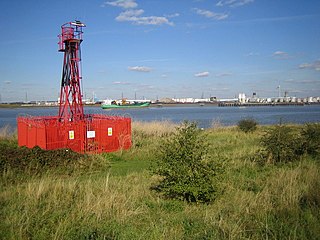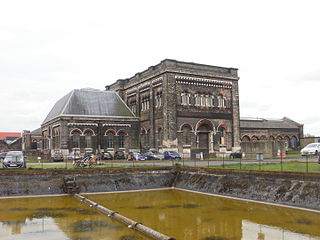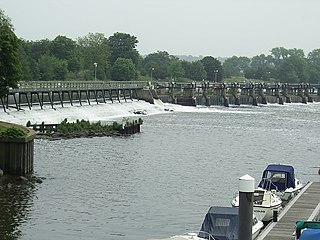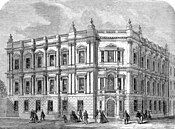Subterranean London refers to a number of subterranean structures that lie beneath London. The city has been occupied by humans for two millennia. Over time, the capital has acquired a vast number of these structures and spaces, often as a result of war and conflict.

Sir Joseph William Bazalgette CB was a 19th-century English civil engineer. As chief engineer of London's Metropolitan Board of Works, his major achievement was the creation of a sewerage system for central London which was instrumental in relieving the city from cholera epidemics, while beginning to clean the River Thames. He was also the designer of Hammersmith Bridge.

The Thames Embankment is a work of 19th-century civil engineering that reclaimed marshy land next to the River Thames in central London. It consists of the Victoria Embankment and Chelsea Embankment.

Beckton is a suburban district in East London, England, within the London Borough of Newham and is located 8 miles (12.9 km) east of Charing Cross. Historically part of Essex, Beckton was unpopulated marshland adjacent to the River Thames until the development of major industrial infrastructure in the 19th century to support the growing metropolis of London. Housing was created in Beckton for workers of the gas and sewage works. Between 1981 and 1995 it was within the London Docklands Development Corporation area, which caused the population to increase as new homes were built and the Docklands Light Railway was constructed.

The original Abbey Mills Pumping Station, in Mill Meads, East London, is a sewage pumping station, designed by engineer Joseph Bazalgette, Edmund Cooper, and architect Charles Driver. It was built between 1865 and 1868, housing eight beam engines by Rothwell & Co. of Bolton. Two engines on each arm of a cruciform plan, with an elaborate Byzantine style, described as The Cathedral of Sewage. Another of Bazalgette's designs, Crossness Pumping Station, is located south of the River Thames at Crossness, at the end of the Southern Outfall Sewer.

The Greenway is a 7-kilometre (4.3 mi) long footpath and bike freeway in London, mostly in the London Borough of Newham, on the embankment containing the Joseph Bazalgette Northern Outfall Sewer.

The Northern Outfall Sewer (NOS) is a major gravity sewer which runs from Wick Lane in Hackney to Beckton sewage treatment works in east London; most of it was designed by Joseph Bazalgette after an outbreak of cholera in 1853 and the "Great Stink" of 1858.

The Southern Outfall Sewer is a major sewer taking sewage from the southern area of central London to Crossness in south-east London. Flows from three interceptory sewers combine at a pumping station in Deptford and then run under Greenwich, Woolwich, Plumstead and across Erith marshes. The Outfall Sewer was designed by Joseph Bazalgette after an outbreak of cholera in 1853 and "The Big Stink" of 1858. Work started on the sewer in 1860 and it was finally opened on 4 April 1865 by H.R.H. the Prince of Wales.

The Thames Tideway Tunnel will be a 25 km (16 mi) combined sewer running mostly under the tidal section (Tideway) of the River Thames across Inner London to capture, store and convey almost all the raw sewage and rainwater that currently overflows into the Thames. These events occur when rainfall volumes exceed the capacity of Bazalgette's London sewerage system.

The Great Stink was an event in Central London in July and August 1858 during which the hot weather exacerbated the smell of untreated human waste and industrial effluent that was present on the banks of the River Thames. The problem had been mounting for some years, with an ageing and inadequate sewer system that emptied directly into the Thames. The miasma from the effluent was thought to transmit contagious diseases, and three outbreaks of cholera before the Great Stink were blamed on the ongoing problems with the river.

Crossness is a location in the London Borough of Bexley, close to the southern bank of the River Thames, to the east of Thamesmead, west of Belvedere and north-west of Erith. The place takes its name from Cross Ness, a specific promontory on the southern bank of the River Thames. In maritime terms, the tip of Cross Ness, in the past referred to as 'Leather Bottle Point', marks the boundary between Barking Reach and Halfway Reach. An unmanned lighthouse on Crossness is a navigational aid to shipping.

Thames Water Utilities Ltd, known as Thames Water, is a large private utility company responsible for the public water supply and waste water treatment in most of Greater London, Luton, the Thames Valley, Surrey, Gloucestershire, north Wiltshire, far west Kent, and some other parts of England; it has a considerable local monopoly. Thames Water is the UK's largest water and wastewater services company, and supplies 2.6 billion litres of drinking water per day, and treats 4.7 billion litres of wastewater per day. Thames Water's 15 million customers comprise 27% of the UK population.

The Crossness Pumping Station is a former sewage pumping station designed by the Metropolitan Board of Works's chief engineer Sir Joseph Bazalgette and architect Charles Henry Driver at the eastern end of the Southern Outfall Sewer and the Ridgeway path in the London Borough of Bexley. Constructed between 1859 and 1865 by William Webster, as part of Bazalgette's redevelopment of the London sewerage system, it features spectacular ornamental cast ironwork, that Nikolaus Pevsner described as "a masterpiece of engineering – a Victorian cathedral of ironwork".

The Tideway is that part of the River Thames in England which is subject to tides. This stretch of water is downstream from Teddington Lock. The Tideway comprises the upper Thames Estuary including the Pool of London.

Beckton Sewage Treatment Works is a sewage treatment plant in Beckton in the London Borough of Newham, East London. It was formerly known as Barking Sewage Works. It was built from 1864 and, now operated by Thames Water, it is one of the largest sewage works in the United Kingdom. It treats the waste water from the Northern Outfall Sewer serving North and East London. The plant has been extended and upgraded several times, most recently in 2011–13, and now covers over 100 hectares.
The Lee Tunnel, also known as the Stratford to East Ham deep tunnel, is a paradigm overflow sewer in East London for storage and conveyance of foul sewage mixed with rainwater. It was built as part of the Thames Tideway Scheme and runs from Abbey Mills Pumping Station down to pumps and storage tanks at Jenkins Lane, Beckton Sewage Treatment Works. It is wholly under the London Borough of Newham.

Mogden Sewage Treatment Works is a sewage treatment plant in the Ivybridge section of Isleworth, West London, formerly known as Mogden. Built in 1931–36 by Middlesex County Council and now operated by Thames Water, it is the third largest sewage works in the United Kingdom. It treats the waste water from about 1.9 million people served by three sewers in North and West London. The plant has been extended to its geographical boundaries and is constantly being upgraded with new process, most recently in OfWat Amp6 by the Costain Atkins Joint venture who delivered 6MW of Combined Heat and Power (CHP) generation, New process air blowers for Batterys A&B and 6 new gravity sludge thickening streams. The site now covers 55 hectares.

The Bondi Ocean Outfall Sewer is a heritage-listed sewerage infrastructure at Blair Street, North Bondi, Waverley Municipality, New South Wales, Australia. The sewer line commences at the intersection of Oxford Street and College Street in Darlinghurst and then travels in a more-or-less easterly direction for 6.1 kilometres (3.8 mi) passing through a number of suburbs until it reaches Blair Street in North Bondi. It was designed and built by the Public Works Department between 1880 and 1889. It is also known as BOOS and Main Northern Ocean Outfall Sewer. The property is owned by Sydney Water, an agency of the Government of New South Wales. It was added to the New South Wales State Heritage Register on 15 November 2002.

Deptford Pumping Station is a sewage pumping station built in 1865 to the east of Deptford. It is part of the London sewerage system devised by Sir Joseph Bazalgette in the mid 19th century. Today operated by Thames Water, it is located on the western side of Norman Road, approximately 0.5 km (0.31 mi) south west of Greenwich town centre, on the eastern bank of Deptford Creek, around 0.5 km (0.31 mi) south of its confluence with the River Thames.
The Crossness Sewage Treatment Works at Crossness (TQ487805) in the London Borough of Greenwich is located at the eastern end of the Southern Outfall Sewer. It was opened in 1865 and is one of the largest sewage works in the United Kingdom. It treats the waste water from the Southern Outfall Sewer serving South and South East London, and is associated with the adjacent Crossness Pumping Station. It is operated by Thames Water.





















